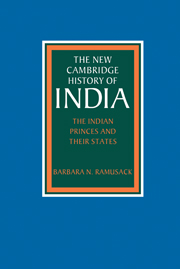Book contents
- Frontmatter
- 1 Introduction: Indian princes and British imperialism
- 2 Princely states prior to 1800
- 3 The British construction of indirect rule
- 4 The theory and experience of indirect rule in colonial India
- 5 Princes as men, women, rulers, patrons, and Oriental stereotypes
- 6 Princely states: administrative and economic structures
- 7 Princely states: society and politics
- 8 Federation or integration?
- Bibliographical Essay
- Glossary
- Index
- THE CAMBRIDGE HISTORY OF INDIA
- References
5 - Princes as men, women, rulers, patrons, and Oriental stereotypes
Published online by Cambridge University Press: 28 March 2008
- Frontmatter
- 1 Introduction: Indian princes and British imperialism
- 2 Princely states prior to 1800
- 3 The British construction of indirect rule
- 4 The theory and experience of indirect rule in colonial India
- 5 Princes as men, women, rulers, patrons, and Oriental stereotypes
- 6 Princely states: administrative and economic structures
- 7 Princely states: society and politics
- 8 Federation or integration?
- Bibliographical Essay
- Glossary
- Index
- THE CAMBRIDGE HISTORY OF INDIA
- References
Summary
Indian princes played multiple roles on diverse stages. Thus their actions triggered complex and sometimes conflicting perceptions among various audiences. The last chapter documented shifting British official images of the princes from natural Indian leaders to loyal allies to naughty schoolboys. But just as British policies did not create the Indian princes as rulers, they influenced but did not circumscribe princely lives and political functions. This chapter explores what it meant to be a ruling prince in India, with particular emphasis on the period from 1870 to 1947. There are four main themes. First, the life cycle of a prince from birth through education to marriage to succession to rulership will exemplify their interlocking private and public lives. Second, an analysis of the sources of legitimacy for Indian rulers and the inconstancy of British policies will disclose opportunities for princes to manoeuvre in the interstices of indirect rule. Third, princely patronage of religious specialists and institutions, visual and performing arts, luxury crafts, secular scholarship, and sports will reveal how princes fostered cultural nationalism while fulfilling their princely dharma. Fourth, an examination of the construction of the princes as concerned, indulgent or decadent rulers, as benevolent fathers and as cunning, inept or naive politicians will detail the shifting perceptions of their disparate audiences as well as the unequal abilities, ambitions and achievements of Indian princes. These images reflect the ambiguous sources of political authority, the tangled ritual and social status of princes, and a mixture of fact and fantasy in public consciousness.
- Type
- Chapter
- Information
- The Indian Princes and their States , pp. 132 - 169Publisher: Cambridge University PressPrint publication year: 2003



